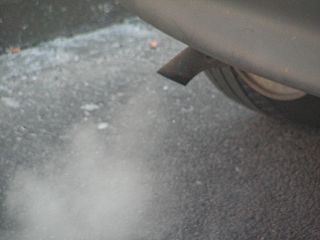From Guest Blogger Jordan: Study Shows 25% of Cars Are Responsible for 90% of Air Pollution

With more and more green vehicles, along with cleaner and more fuel-efficient gasoline-powered cars, hitting the road in recent years, the results of a new study showing that only a small fraction of all vehicles that are in use today are responsible for the vast majority of the toxic air pollutant emissions, come as no surprise.
Researchers at the University of Toronto have conducted a study to determine what kinds of cars are causing most of the pollution, discovering that air quality is mostly affected by emissions released by old and “badly tuned” cars and trucks.
Based on the analysis of the emissions of 100,000 vehicles, a group of University of Toronto engineers found that only 25% of cars produce 90% of air pollution, which suggests that this serious threat to public health could be eliminated easily, given that it is caused by a relatively small number of vehicles.
To determine the exact amount of emissions released by each car, the scientists installed air sampling probes on College Street in Toronto, which is one of the city’s busiest roads, and after analyzing the readings, they learned that 95 percent of the soot, 93 percent of the carbon monoxide, 76 percent of the volatile organic compounds (which include benzene, toluene, ethylbenzene), is generated by only a quarter of the vehicles. Volatile organic compounds have long-term health effects and are known to cause lung cancer, among other diseases.
“The most surprising thing we found was how broad the range of emissions was,” said Greg Evans, University of Toronto chemical engineer. “As we looked at the exhaust coming out of individual vehicles, we saw so many variations. How you drive, hard acceleration, age of the vehicle, how the car is maintained – these are things we can influence that can all have an effect on pollution.”
In addition to this, researchers found that pollutant concentrations are double their normal levels about 300 yards away from highways, meaning those who live at this kind of distance from major roads are at a very high risk of getting a disease associated with poor air quality.
The researchers conclude that air pollution from cars could be reduced by implementing some relatively inexpensive measures, such as targeting clunkers and enforcing stricter emission tests.

Very true, In the UK we now have a situation where toxic emissions from motor vehicles are thought to be a far bigger killer than vehicular collisions, with greater than 90% of deaths associated with vehicles arising from these emissions.
This being the case, it can be argued that vehicles are at least 10 times as dangerous as most people think they are, and that by far the most cost effective mitigation strategy would be to eliminate the very worst offenders from the roads.
Of course, in terms of pollution, you would need to multiply the dirtiness of a vehicle’s exhaust by the annual distance it travels, then possibly take account of where the vehicle is used – a delivery vehicle in central London will have a far higher health impact than an agricultural tractor used in the Shetland Islands.
Taking a classic / vintage car off the roads when it is only driven for a few hundred miles a year will make little difference, whilst removing a dirty old refrigerated truck – driven for 8 to 10 hours every day, and then parked up with its engine ticking over to keep the fridge running will make a huge difference.
I have suggested to my member of parliament a scheme where
1. Classic / vintage vehicles are given a waiver for a limited capped mileage each year.
2. Other dirty vehicles are offered a grant to either scrap or re-power the vehicle with a cleaner drive train i.e. a newer engine, LPG, or electric.
3. In 2 to give priority to vehicles likely to be heavily used, Taxis, Private hire vehicles (similar to taxis), buses, coaches, and delivery vehicles, especially those registered to urban dwellers.
4. Exclusion from certain zones of higher polluting vehicles in and around the largest cities and other areas with a particular pollution problem.
Smart targeting of the worst offending 2% of vehicles each year should be achievable on a relatively modest budget, perhaps by levying a small additional charge on fuel, and would in my opinion be worth paying a few pence a day extra to achieve.